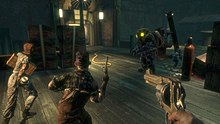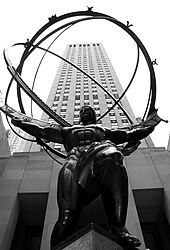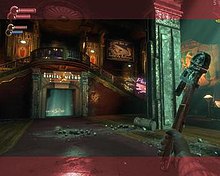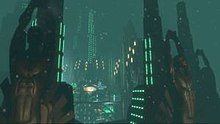BioShock
The game follows player character Jack, who discovers the underwater city of Rapture, built by business magnate Andrew Ryan to be an isolated utopia.
BioShock's concept was developed by Irrational's creative lead, Ken Levine, and incorporates ideas by 20th century dystopian and utopian thinkers such as Ayn Rand, George Orwell, and Aldous Huxley, as well as historical figures such as John D. Rockefeller Jr. and Walt Disney.
BioShock takes place in Rapture,[5][6] a large underwater city planned and constructed in the 1940s by individualist business magnate Andrew Ryan, who wanted to create a utopia for society's elite to flourish outside of government control and "petty morality".
This philosophy resulted in remarkable advances in the arts and sciences, which included the discovery of "ADAM": a potent gene-altering substance which is created by a species of sea slug on the ocean floor.
[7] As Rapture flourished, wealth disparities grew, and criminal Frank Fontaine used his influence over the disenfranchised working class to establish illegal enterprises and obtain power—enough to rival Ryan.
In the months that followed, a man amongst the poor named Atlas rose up and began a violent revolution against Ryan, with both sides using plasmid-enhanced humans (known as "Splicers") to wage war on one another.
The conflict turns Rapture into a war-torn crumbling dystopia, resulting in societal collapse, countless deaths, many Splicers becoming disfigured and insane from ADAM abuse, and the few sane survivors barricading themselves away from the chaos.
Levine had attempted to pitch a sequel to System Shock 2 to Electronic Arts, but the publisher rejected the idea based on the poor performance of the earlier game.
[27] Irrational developed other games, including Freedom Force, Tribes: Vengeance, the canceled title Deep Cover, and the completed The Lost which was never released due to legal complications.
[28][32][33] By this point, the story and setting had changed significantly, taking place in an abandoned World War II-era Nazi laboratory that had been recently unearthed by 21st-century scientists.
[27] Levine found that the cyberpunk theme had been overplayed considering their initial reject from Electronic Arts for System Shock 3, leading towards the underwater setting of Rapture.
[41] He brought in the ideas of Objectivism that Rand primarily outlined in the book Atlas Shrugged, that man should be driven by selfishness and not altruism, and used this to inform the philosophy behind the city of Rapture and Andrew Ryan's work, viewing them as quite ludicrous, and primed to be applied to an antagonist, tied in with his previous observations on Rockefeller and his writings.
[41] Regarding artistic influences, Levine cited the books Nineteen Eighty-Four and Logan's Run, representing societies that have "really interesting ideas screwed up by the fact that we're people".
[43] The idea of the mind control used on Jack was offered by LeBreton, inspired by films like The Manchurian Candidate, as a means to provide a better reason to limit the player's actions as opposed to the traditional use of locked doors to prevent them exploring areas they should not.
One such case was an apparent Easter egg found in the remastered version in 2018, where under certain conditions, the player can end up looking at an object with the description "Paul Hellquist did not do his Job".
"[45] A critical playtest of the game occurred in January 2007, where initial feedback from the players was mostly negative, including issues of the setting being too dark, having no idea where to go, and distrusting Atlas, who at the time was voiced in a southern drawl, described as a "lecherous Colonel Sanders".
[27] The team took this criticism to heart, revamping several elements during those extra months such as improving the lighting, implementing a quest marker, and using an Irish voice for Atlas to make him sound more trustworthy.
[27] In a 2016 interview, Levine felt that the game could have used about six more months of development to improve the gun combat system and fix lagging issues that occurred during the final boss fight.
Levine, who considers himself culturally Jewish but does not follow Judaism, had grown up in New Jersey but spent much of his childhood time with his father who worked in Manhattan's Diamond District and visiting his grandparents in Queens, a neighborhood with a large proportion of Eastern European immigrants.
He composed his pieces to blend with the chosen licensed music as to keep the same feel, while also trying to bring out something that was "eerie, frightening and at times beautiful" to mesh well with Rapture's environments.
[3][70] One addition was "Survivor Mode", in which the enemies were made tougher, and Vita-Chambers provided less of a health boost when used, forcing the player to be more creative in approaching foes and to rely more on the less-used plasmids in the game.
Several parts of the game were reduced to single image graphics and the main gameplay engine had to use low-resolution and low-polygon models due to the limitations of mobile phones at the time of its release.
"[108] The New York Times reviewer described it as: "intelligent, gorgeous, occasionally frightening" and added: "Anchored by its provocative, morality-based story line, sumptuous art direction and superb voice acting, BioShock can also hold its head high among the best games ever made.
"[109] GameSpy praised BioShock's "inescapable atmosphere",[110] and Official Xbox Magazine lauded its "inconceivably great plot" and "stunning soundtrack and audio effects".
[116] Daniel Friedman for Polygon concurred with Blow, noting that the player only loses 10% of the possible ADAM rewards for saving the Little Sisters rather than killing them, and felt that this would have been better instituted as part of the game difficulty mechanic.
[163][164] Irrational included an option for "Horizontal FOV Lock" in the December 2007 patch that allows widescreen users a wider field of view, without cutting anything off the image vertically.
In their book, Digital Culture: Understanding New Media, Glen Creeber and Royston Martin perform a case study of BioShock as a critical analysis of video games as an artistic medium.
[187] To determine what artwork would be used for the Limited Edition cover, 2K Games ran a contest, with the winning entry provided by Crystal Clear Art's owner and graphic designer Adam Meyer.
[188] On April 23, 2007, the Cult of Rapture website confirmed that the Limited Collector's Edition would include a 6-inch (150 mm) Big Daddy figurine (many of which were damaged due to a dropped shipping container; a replacement initiative is in place), a "Making Of" DVD, and a soundtrack CD.
[193][194] Until October 1, 2007, 2K Games was sending a printed version of the book to the owners of the collector's edition whose Big Daddy figurines had been broken, as compensation for the time it took to replace them.



